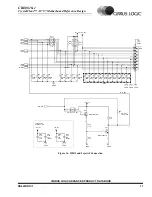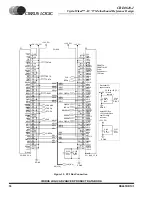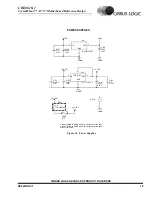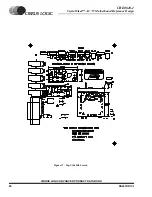
DS241RD1C1
5
CRD4610-1
CrystalClear™ AC '97 Motherboard Reference Design
CIRRUS LOGIC ADVANCED PRODUCT DATABOOK
Other Reference Card Features
Other reference card features that are not associat-
ed with the other sections are the external volume
control buttons, the joystick/MIDI connection, and
the power regulators.
Volume Control Buttons
The volume control buttons are connected to the
CS4610 and act as a master volume control. The
four-pin header can be populated to provide a cable
connection for volume control buttons that can be
placed elsewhere in the system. There is a volume
up button and a volume down button. Pressing both
buttons at the same time enables the mute/unm-
mute function.
Joystick/MIDI connection
The DB-15 connector allows a joystick or an exter-
nal MIDI device to be connected to the CS4610. In
the AC’ 97 configuration, the CS4610 handles the
joystick operation. The external connection can
also take MIDI data from an external source to the
CS4610. A buffer circuit allows the MIDIOUT pin
of the CS4610 to drive an external MIDI input.
Power Regulators
There are two power regulators on the board. One
is a Linear Technologies LT117CST-3.3 voltage
regulator that derives the +3.3 V supply for the
CS4610 and the CS4297 from the +5 V on the PCI
bus. This regulator is unnecessary on mother
boards with a +3.3 V supply. The regulator was
used in this reference design because the +3.3 V
PCI bus power pins are not guaranteed to be on the
PCI bus connector. The card is also designed to be
used in a 5 V PCI Connector [2].
A Motorola MC78M05CDT regulates the PCI
+12 V supply down to provide a clean +5 V analog
supply for the operational amplifiers and the
CS4297. A power regulator is recommended for
the analog voltage supply to provide good audio
signal quality. The MC78M05CDT regulator can
provide up to 500 mA of current with adequate
heat-sinking, which is enough power for the
CS4297 and the three audio op-amps. The
MC78L05 power regulators do not provide enough
current to power the same devices, and are not rec-
ommended for use with the CS4297.
SCHEMATIC DESCRIPTION
Figures 1 through 8 show the schematics for the
CRD4610-1 card. This section will describe partic-
ular pages of the schematic that need to be dis-
cussed.
Figure
7
: CD Audio Input
C5 and C6 are used in parallel to make a 2
µ
F ca-
pacitor on the CD Common line because the input
impedance on that line is half of what is on the CD
In Right and CD In Left. A 2
µ
F capacitor could be
used, but many of the 2
µ
F capacitors tested have
shown distortion problems.
Figure
3
: CS4297
A 10
µ
F electrolytic capacitor should be added
next to pins 25 and 26 if the capacitor connected to
the output of the power regulator is located far
away from the CS4297. For the best audio perfor-
mance, the analog voltage regulator should be lo-
cated near the CS4297. R1 and R2 are termination
resistors in the serial AC link between the CS4297
and the CS4610. NPO-type capacitors should be
used on all loading capacitors of audio signals to
ensure minimal added distortion.
Figure
2
: CS4610
The 0.1
µ
F capacitors connected to the power pins
of the CS4610 should be as close as possible to the
chip. The inductor L6 is used to filter the power
supply for the internal PLL circuit. R7 can be re-
moved from a production design, and pin 51 can be
connected directly to digital ground. R3 and R4 are
termination resistors in the serial AC link between
the CS4297 and the CS4610.
Содержание CRD4610-1
Страница 30: ......






































